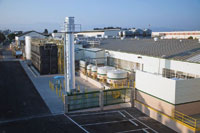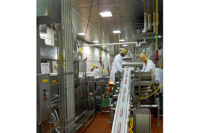
That certainly applies to Gill’s Onions LLC. Just as an onion has layers, this 26-year-old family company in Oxnard, Calif., has layers of plant initiatives.
Besides several noteworthy food safety achievements, Gill’s was a founding member of the Climate Registry, a Los Angeles coalition committed to green house gas (GHG) emissions measurement, management and reduction. Moreover, the company also has earned state, national and even worldwide recognition for breakthrough technology billed as an Advanced Energy Recovery System (AERS).
For the record, Gill’s is quite possibly the world’s largest onion processor – handling about 1 million pounds of onions daily and producing various types of refrigerated onion products for retail, foodservice and industrial channels.
To use the best part of an onion, Gill’s eliminates the top, tail and a few outside layers. That generates an estimated 300,000 pounds of waste each day. A vertically integrated company, Gill’s used to collect, haul and spread that waste on nearby fields.
It was around 1999, however, that company co-owner Steve Gill realized something had to change.
“We were just running out of ground here to [stockpile waste material],” he says. “As business grew, so did the waste and it was becoming too expensive and unmanageable. It was costing about $400,000 a year to just [maintain the practice]. I thought it would be better to put that money into a project like [AERS] … to stop the waste and solve the problem right here.”
That led Gill’s Onions to figuratively break new ground – and consider every technology and procedure to process and re-use onion waste. Having collaborated with university, state utility and private industry researchers, the company last year completed a $9.5 million multi-step installation.
In operation since last July, AERS includes technologies to (1) grind and dewater onion peels (reducing solid waste by 75 percent), (2) feed the onion juice to an anaerobic digester to produce bio-methane gas, (3) use specialized fuel cells to convert biogas into clean, usable electric energy and (4) process and press the remaining 25 percent of solid onion waste into high value cattle feed for non-milking cows.
Thus, Gill’s Onions now utilizes 100 percent of its daily product waste. Moreover, utility data verify that AERS is powering two 300-kilowatt fuel cells, which provide the company with its entire base-load electricity requirements (or enough to power 460 homes).
Interestingly, Gill’s officials note that the company already has received $2.7 million in outside assistance funding, energy rebates and research funding. With that, Gill’s expects the AERS project to pay for itself – while officials make even more improvements – within six years.
Meanwhile, because AERS serves as an in-house electric power source, officials note that the company can “greatly reduce” its power-related GHG emissions.
Sustainability Director Nikki Rodoni says Gill’s is working on a group project with graduate students from the University of California at Santa Barbara (UCSB)’s Donald Bren School of Environmental Science and Management. The group recently helped Gill’s complete the company’s first review of energy use, GHG inventory and reporting. Officials at The Climate Registry, Los Angeles, verified the emissions inventory and accepted 2008 data as Gill’s base year.
“Although tedious, the process of accounting for all sources of energy use and emissions, offers numerous benefits,” says Rodoni. “First, we believe that if it isn’t counted, it can’t be improved and now we have a baseline accounting of the costs, energy usage and emissions across our entire organization.
“Secondly, with the implementation of AERS, we expect to improve on all fronts – involving energy costs, demand and GHG levels – and now we will have an official, verifiable way to measure and market these improvements,” she continues. “Lastly, in the event of state or federally mandated greenhouse gas reporting, we believe we will be a step ahead by starting early, learning the verification process and working to improve the sustainability of our company.”
Student researchers from UCSB’s Bren School also are cutting their teeth on Gill’s “zero waste” initiative.
“They have gone through our entire organization – analyzing our energy, water, onion and material consumption and identifying ways that Gills Onions can conserve, recycle, recover, reuse and replace – thereby eliminating as much as possible,” says Rodoni. “All of these initiatives will save money, reduce our environmental impact and improve our sustainability.”
At a glance:
Company: Gill’s Onions LLC
Food plant(s) honored: Oxnard, Calif.
Selection criteria: Environmental innovation
Employees: 450
Facility size: 100,000 square feet
Products: Processed onions
AERS awards/California recognition: California 2009 Governor’s Environmental and Economic Leadership Award, American Counsel of Engineering Companies (ACEC) Golden State Award
AERS awards/national recognition: Energy Solutions Center “Partnership Award.” Gill’s AERS also was in consideration for a national ACEC award, to be announced in late February.

